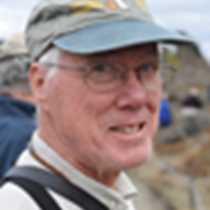Tracy Arm and Sand Bay, Southeast Alaska
In the dark of the night - such of it as there is in the Alaskan summer - the National Geographic Sea Bird departed from Juneau, and our trip through Southeast Alaska was underway. In the early morning, we turned into Tracy Arm, a fjord system that cuts into the mountains of Coastal Alaska. A fjord is a glacially carved valley that is now flooded by the sea. All of the waterways through which we travel have been carved by glaciers that advance in the glacial episodes and retreat during the warmer interglacial interludes over the last two and a half million years or so. Even when a glacier is stable or retreating, the ice is always moving forward as new ice is created in the mountains, flows downhill, and drops into the sea. Tracy Arm is one of the must spectacular of fjords. Steep valley walls rise up to rounded peaks far above us, and U-shaped valleys that were once filled with tributary glaciers enter from the sides.
Two tidewater glaciers, the Sawyer and South Sawyer, lie at the head of Tracy Arm and the waterway comes to an abrupt end. The National Geographic Sea Bird drifted as we boarded our Zodiacs and cruised through the ice-clogged water to approach the face of the South Sawyer Glacier. A massive splash in the distance signaled a large calving event as a huge chunk of ice fell from the glacier. Minutes later we found it floating like a blue, medieval castle. Like other Alaskan glaciers, and indeed, most of the world's glaciers, the two Sawyer glaciers are in rapid retreat as they drop ice into the sea faster than it is being renewed from the mountains above. A comparison of photos taken over the last ten years showed this clearly. It may be but a few years before they no longer reach the sea.
Harbor seals come to end of the fjord to bear their pups on floating ice. Mothers with their new pups dotted the ice. Harbor seals are declining in abundance, and we kept a respectful distance to avoid disturbing them. Their afterbirths, left on the ice, provided meals for immature bald eagles, gulls, ravens, and northwestern crows. One young seal pup seemed determined to ignore its mother's instructions and approached our Zodiacs to gaze up at us before its mother pushed it away.
We turned back down the fjord and exited to our afternoon destination of Sand Bay, where we had our first walk through the forest. The Tongass National Forest of Southeast Alaska contains the last remaining large, contiguous stands of Pacific Northwest temperate rainforest. Towering Sitka spruce and western hemlock trees dominate the forest, with a rich understory of mosses, ferns, herbs, and shrubs. The forest is interspersed with tidally influenced meadows that are now bursting forth in colorful flowers: yellow buttercups, red paintbrush, and the bronze-purple-brown of the chocolate lilies. Tracks of river otters and wolves in the streamside sand attest to the recent passage of these symbols of wild Alaska. We are fortunate that, for this brief moment, we can share it with them. May it always be so.




